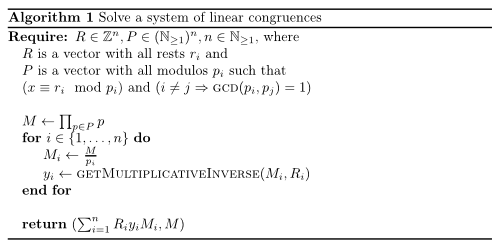When you have a system of linear congruences like:
$$ \begin{align} x &\equiv 4 \mod 19\ x &\equiv 12 \mod 37\ x &\equiv 14 \mod 43 \end{align} $$
you can solve it quite easily. Johannes Schickling has written a very nice JavaScript Application that applies the following algorithm online. I've used his source code to write the following Python code.
Pseudocode

Python
#!/usr/bin/env python
# -*- coding: utf-8 -*-
def ExtendedEuclideanAlgorithm(a, b):
"""
Calculates gcd(a,b) and a linear combination such that
gcd(a,b) = a*x + b*y
As a side effect:
If gcd(a,b) = 1 = a*x + b*y
Then x is multiplicative inverse of a modulo b.
"""
aO, bO = a, b
x = lasty = 0
y = lastx = 1
while b != 0:
q = a / b
a, b = b, a % b
x, lastx = lastx - q * x, x
y, lasty = lasty - q * y, y
return {"x": lastx, "y": lasty, "gcd": aO * lastx + bO * lasty}
def solveLinearCongruenceEquations(rests, modulos):
"""
Solve a system of linear congruences.
>>> solveLinearCongruenceEquations([4, 12, 14], [19, 37, 43])
{'congruence class': 22804, 'modulo': 30229}
"""
assert len(rests) == len(modulos)
x = 0
M = reduce(lambda x, y: x * y, modulos)
for mi, resti in zip(modulos, rests):
Mi = M / mi
s = ExtendedEuclideanAlgorithm(Mi, mi)["x"]
e = s * Mi
x += resti * e
return {"congruence class": ((x % M) + M) % M, "modulo": M}
if __name__ == "__main__":
import doctest
doctest.testmod()